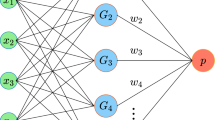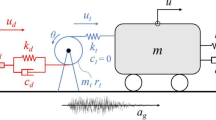Abstract
For describing target motion in hypersonic vehicle defense, a parametric analyzing and modeling method on ballistic data is proposed based on time varying auto-regressive method. Ballistic data are regarded as non-stationary random signal, where the hidden internal law is studied. Firstly, ballistic data are decomposed into smooth linear trend signal and non-stationary periodic skip signal with ensemble empirical mode decomposition method to avoid mutual interference between different modal data. Secondly, the linear trend signal and the periodic skip signal are modeled separately. The linear trend signal is approximated by power function regressive estimator and the periodic skip signal is modeled based on time varying auto-regressive method. In order to determine optimal model orders, a novel method is presented based on information theoretic criteria and the criteria of minimizing the mean absolute error. Finally, the consistency test is conducted by investigating the time-frequency spectrum characteristics and statistical properties of outputs of the parametric model established above and dynamics model under the same initial condition. Simulation results demonstrate that the parametric model established by the proposed method shares a high consistency with the original dynamics model.
Similar content being viewed by others

References
Zhang T T, Wang Z G, Huang W, et al. Performance comparison between waverider and wide-speed-range gliding vehicle based on CFD approaches. Sci China Tech Sci, 2019, 62: 1861–1870
Zhou J, Lei H M. Coverage-based cooperative target acquisition for hypersonic interceptions. Sci China Tech Sci, 2018, 61: 1575–1587
Chen X Q, Hou Z X, Liu J X, et al. Phugoid dynamic characteristic of hypersonic gliding vehicles. Sci China Inf Sci, 2011, 54: 542–550
Li J, Gao C, Jing W, et al. Nonlinear vibration analysis of a novel moving mass flight vehicle. Nonlinear Dyn, 2017, 90: 733–748
Shahverdi H, Khalafi V. Bifurcation analysis of FG curved panels under simultaneous aerodynamic and thermal loads in hypersonic flow. Composite Struct, 2016, 146: 84–94
Liu Z, Gao C, Li J, et al. Closed-loop bifurcation analysis for a novel moving mass flight vehicle. Int J Aeronaut Space Sci, 2018, 19: 962–975
Salles L, Staples B, Hoffmann N, et al. Continuation techniques for analysis of whole aeroengine dynamics with imperfect bifurcations and isolated solutions. Nonlinear Dyn, 2016, 86: 1897–1911
Zhang L, Nie L, Cai B, et al. Switched linear parameter-varying modeling and tracking control for flexible hypersonic vehicle. Aerospace Sci Tech, 2019, 95: 105445
Zhu J, Liu L, Tang G, et al. Three-dimensional robust diving guidance for hypersonic vehicle. Adv Space Res, 2016, 57: 562–575
An H, Liu J, Wang C, et al. Disturbance observer-based antiwindup control for air-breathing hypersonic vehicles. IEEE Trans Ind Electron, 2016, 63: 3038–3049
Zhu J W, Liu L H, Tang G J, et al. Three-dimensional nonlinear coupling guidance for hypersonic vehicle in dive phase. Sci China Tech Sci, 2014, 57: 1824–1833
Simon N R. Fourier decomposition of RR lyrae pulsations—theory versus observations. Astrophys J, 1985, 299: 723–727
Daubechies I, Lu J, Wu H T. Synchrosqueezed wavelet transforms: An empirical mode decomposition-like tool. Appl Comput Harmonic Anal, 2011, 30: 243–261
Lei Y, Lin J, He Z, et al. A review on empirical mode decomposition in fault diagnosis of rotating machinery. Mech Syst Signal Processing, 2013, 35: 108–126
Marıa E T, Marcelo A C, Gaston S, et al. A complete ensemble empirical mode decomposition with adaptive noise. In: Proceedings of the IEEE International Conference on Acoustics, Speech, and Signal Processing (ICASSP). Prague: IEEE, 2011. 4144–4147
Eom K B. Analysis of acoustic signatures from moving vehicles using time-varying autoregressive models. Multidimensional Syst Signal Processing, 1999, 10: 357–378
Kaipio J P, Karjalainen P A. Estimation of event-related synchronization changes by a new TVAR method. IEEE Trans Biomed Eng, 1997, 44: 649–656
Vu D H, Muttaqi K M, Agalgaonkar A P, et al. Short-term electricity demand forecasting using autoregressive based time varying model incorporating representative data adjustment. Appl Energy, 2017, 205: 790–801
Wang S, Liu M. The study on the acceleration signal processing based on the TVAR method. In: Proceedings of the WASE International Conference on Information Engineering. Taiyuan: IEEE, 2009. 70–73
Han X, Wang B S, Liu H W, et al. A micro-doppler frequency estimation method for micro-motion object using TVAR model. In: Proceedings of the International Radar Conference. Xi’an: IET, 2013. 1–5
Zhang L, Xiong G, Liu H, et al. Time-frequency representation based on time-varying autoregressive model with applications to non-stationary rotor vibration analysis. Sadhana, 2010, 35: 215–232
Hai Y, Wei C, Hong Z. TVAR time-frequency analysis for non-stationary vibration, signals of spacecraft. Chin J Aeronaut, 2008, 21: 423–432
Abramovich Y I, Spencer N K, Turley M D E. Order estimation and discrimination between stationary and time-varying autoregressive (TVAR) models. IEEE Trans Signal Process, 2007, 55: 2861–2876
Li Y, Luo M L, Li K. A multiwavelet-based time-varying model identification approach for time-frequency analysis of EEG signals. Neurocomputing, 2016, 193: 106–114
Zhao K, Cao D Q, Huang W H. Maneuver control of the hypersonic gliding vehicle with a scissored pair of control moment gyros. Sci China Tech Sci, 2018, 61: 1150–1160
Zhang Y L, Liu L H, Tang G J, et al. Trajectory generation of heat load test based on gauss pseudospectral method. Sci China Tech Sci, 2018, 61: 273–284
Zhao D J, Song Z Y. Reentry trajectory optimization with waypoint and no-fly zone constraints using multiphase convex programming. Acta Astronaut, 2017, 137: 60–69
Dong Q, Zhang C. Trajectory optimization for RLV in TAEM phase using adaptive Gauss pseudospectral method. Sci China Inf Sci, 2019, 62: 10206
Li Z, Yang X, Sun X, et al. Improved artificial potential field based lateral entry guidance for waypoints passage and no-fly zones avoidance. Aerospace Sci Tech, 2019, 86: 119–131
Wang H Y. Nonstationary Random Signal Analysis and Processing (in Chinese). Beijing: National Defense Industry Press, 1999. 307–309
Chon K H, Zhao H, Zou R, et al. Multiple time-varying dynamic analysis using multiple sets of basis functions. IEEE Trans Biomed Eng, 2005, 52: 956–960
Phillips T H. A common aero vehicle (CAV) model, description, and employment guide. Schafer Corporation Technical Report for AFRL and AFSPC. 2003
Perolat J, Couso I, Loquin K, et al. Generalizing the Wilcoxon rank-sum test for interval data. Int J Approximate Reasoning, 2015, 56: 108–121
Ferguson B G, Quinn B G. Application of the short-time Fourier transform and the Wigner-Ville distribution to the acoustic localization of aircraft. J Acoust Soc Am, 1994, 96: 821–827
Author information
Authors and Affiliations
Corresponding author
Rights and permissions
About this article
Cite this article
Hu, Y., Li, J., Zhang, Z. et al. Parametric modeling of hypersonic ballistic data based on time varying auto-regressive model. Sci. China Technol. Sci. 63, 1396–1405 (2020). https://doi.org/10.1007/s11431-020-1652-4
Received:
Accepted:
Published:
Issue Date:
DOI: https://doi.org/10.1007/s11431-020-1652-4



